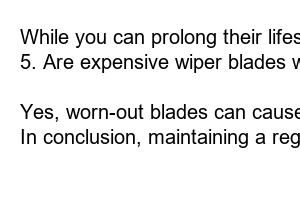와이퍼 교체 주기
Title: Maintaining Clear Vision: The Importance of Regular Wiper Replacement Cycle
Introduction:
Imagine driving under heavy rain, struggling to see through a smeared windshield. We’ve all been there, and it’s not only frustrating but also hazardous. One critical component that plays a crucial role in maintaining visibility is our car’s wiper blades. In this blog post, we will explore the significance of adhering to a regular wiper replacement cycle to ensure optimal performance and safe driving.
1. The Lifespan of Wiper Blades:
Wiper blades, just like any other car part, have a limited lifespan. On average, they last approximately 6-12 months, depending on various factors such as weather conditions, usage frequency, and the quality of the blades. **Regular inspection** and replacement when needed are highly recommended.
2. Signs of Worn-Out Blades:
As wiper blades age, they start to exhibit signs of wear and tear. Look out for **streaking**, **chattering**, **skipping**, or **leaving unwiped areas** on the windshield, even after cleaning. This indicates that the blades have lost their effectiveness and must be replaced promptly to ensure clear vision.
3. The Impact of Weather Conditions:
Extreme weather conditions can take a toll on wiper blades. Exposure to intense heat, freezing temperatures, or prolonged sun exposure causes rubber components to deteriorate faster. If you frequently drive in areas with these conditions, it may be necessary to replace the blades more often.
4. Long-Term Consequences of Neglect:
Ignoring timely wiper blade replacement can have serious consequences. Worn-out blades greatly reduce driver visibility, posing a significant safety risk. Furthermore, blades that leave streaks can hinder the effectiveness of windshield cleaners, making it harder to clean off dirt, dust, or bugs.
5. Benefits of Regular Wiper Blade Replacement:
By adhering to a regular wiper replacement cycle, you can enjoy several benefits. It guarantees a consistently **clear windshield**, enhancing your visibility and overall driving experience. Additionally, new blades efficiently remove debris, reducing the risk of scratches or damage to the windshield surface.
6. How to Choose the Right Replacement Blades:
When replacing your wiper blades, ensure you choose the right ones for your specific vehicle make and model. Consult your car’s manual or seek professional advice to select **correctly sized blades** that are compatible with your wiper arm design.
FAQs:
1. How often should I replace my wiper blades?
It is recommended to replace wiper blades every 6-12 months, or as soon as signs of wear and reduced visibility become noticeable.
2. Can I replace my wiper blades myself?
Yes, most wiper blades are designed for easy replacement. Simply follow the instructions provided with the new blades or seek assistance from a car maintenance professional if needed.
3. How do I know if my wiper blades need replacement?
Look for signs of streaking, chattering, skipping, or unwiped areas on your windshield. These indicate it’s time to replace your blades.
4. Can I extend the lifespan of my wiper blades?
While you can prolong their lifespan by keeping the windshield clean and avoiding extreme weather conditions, it is always advisable to replace them when their effectiveness diminishes.
5. Are expensive wiper blades worth it?
High-quality blades may have a longer lifespan and provide better performance, making them a worthwhile investment for those seeking optimal visibility and durability.
6. Can worn-out wiper blades damage my windshield?
Yes, worn-out blades can cause scratching or damage to the windshield surface, especially when dirt and debris are not properly wiped away.
In conclusion, maintaining a regular wiper replacement cycle is essential for clear vision and safe driving. By recognizing the signs of worn-out blades and promptly replacing them, you can enhance visibility, prolong the life of your windshield, and drive with confidence in any weather condition. Make wiper blade care a top priority to ensure the safety of yourself and others on the road.

